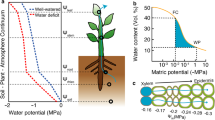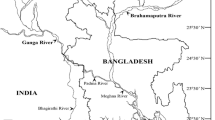Abstract
All of the cells of the upper (adaxial) epidermis of the leaves ofOxalis carnosa are transformed into large bladders, while in the lower epidermis the bladder cells are interrupted by “normal” cells with stomata. The epidermal bladders contain a high concentration of free oxalic acid (pH approx. 1). Water-relations parameters of these epidermal bladder cells have been determined using the pressure probe. Original cell turgor (P0) of the closely packed bladders of theupper epidermis was P0=0.7 to 2.9 bar (\(\overline {P_0 } = 1.7 \pm 0.5 bar\); mean±SD;N=25 cells) and lower than that in the club-shaped bladders of thelower epidermis (P0=1.3 to 3.7 bar;\(\overline {P_0 } = 2.5 \pm 0.7 bar\);N=25 cells). Large differences in the elastic modulus (ε) and the hydraulic conductivity (Lp) of the two different types of cells were observed. For the lower epidermal bladders, ε=18 to 166 bar and was similar to that of other higher plant cells. Also, for these cells it was found that ε was increasing with both, cell turgor and cell volume. By contrast, ε of the cells of the upper epidermis was by one order of magnitude smaller (ε=1.9 to 17.0 bar) and no dependence of ε on cell volume could be detected. The Lp values of the cell membranes were also different (lower epidermis:\(\overline {Lp} = (2.3 \pm 1.6) \cdot 10^{ - 5} cm s^{ - 1} bar^{ - 1}\); upper epidermis:\(\overline {Lp} = (3.8 \pm 2.4) \cdot 10^{ - 6} cm s^{ - 1} bar^{ - 1}\)). These differences seem to be too large to be caused by errors in determining the exchange area for water (A) between cells and adjacent tissue. The half-times of water exchange between bladders and leaf (T1/2) were, on average, somewhat longer for the upper than for the lower epidermis (lower epidermis: T1/2=7 to 38 s; upper epidermis: T1/2=22 to 213 s), but the differences in the T1/2 values were not as distinct as for ε and Lp. This is because of the compensatory effects of ε, Lp and the different ratios of volume to exchange area. Since the bladders make up about 75% of the entire volume of the leaf, it is assumed that the rate of response of the leaf to changes in the water potential should be similar to that of the bladder cells. The results are discussed in terms of a possible function of the bladders in the leaf.
Similar content being viewed by others
Abbreviations
- P:
-
cell turgor
- Lp:
-
hydraulic conductivity of cell membrane
- T1/2 :
-
half-time of water exchange between cell and surroundings
- ε:
-
volumetric elastic modulus
- A:
-
exchange area for water of cell
- V:
-
cell volume
- πi :
-
osmotic pressure of the cell sap
References
Dainty, J. (1976) Water relations of plant cells. In: Encyclopedia of plant physiology, N. S., vol. 2: Transport in plants II, pt. A: Cells, pp. 12–35, Lüttge, U., Pitman, M.G., eds. Springer, Berlin Heidelberg New York
Hill, A.E., Hill, B.S. (1976) Elimination processes by glands: mineral ions. In: Encyclopedia of plant physiology, N. S., vol. 2: Transport in plants II, pt. B: Tissues and organs, pp. 225–243, Lüttge, U., Pitman, M.G., eds. Springer, Berlin Heidelberg New York
Lüttge, U. (1975) Salt glands. In: Ion transport in plant cells and tissues, pp. 335–376, Baker, D.A., Hall, J.L., eds. North-Holland Publ. Co., Amsterdam
Lüttge, U., Fischer, E., Steudle, E., (1978) Membrane potentials and salt distribution in epidermal bladders and photosynthetic tissue ofMesembryanthemum crystallinum L. Plant Cell Environ.1, 121–129
Steudle, E., Lüttge, U., Zimmermann, U. (1975) Water relations of the epidermal bladder cells of the halophytic speciesMesembryanthemum crystallinum: direct measurement of hydrostatic pressure and hydraulic conductivity. Planta126, 229–246
Steudle, E., Smith, J.A.C., Lüttge, U. (1980) Water relation parameters of individual mesophyll cells of the CAM plantKalanchoë daigremontiand. Plant Physiol.66, 1155–1163
Steudle, E., Zimmermann, U., Lüttge, U. (1977) Effect of turgor pressure and cell size on the wall elasticity of plant cells. Plant Physiol.59, 285–289
Steudle, E., Zimmermann, U., Zillikens, J. (1982) Effect of cell turgor on hydraulic conductivity and elastic modulus ofElodea leaf cells. Planta154, 371–380
Tomos, A.D., Steudle, E., Zimmermann, U., Schulze, E.-D. (1981) Water relations of leaf epidermal cells ofTradescantia virginiana. Plant Physiol.68, 1135–1143
Tyerman, S.D., Steudle, E. (1982) Comparison between osmotic and hydrostatic water flows in higher plant cell: determination of hydraulic conductivities and reflection coefficients in isolated epidermis ofTradescantia virginiana. Aust. J. Plant Physiol.9, 461–480
Ziegler, H., Lüttge, U. (1966) Die Salzdrüsen vonLimonium vulgare. I. Die Feinstruktur. Planta70, 193–206
Ziegler, H., Lüttge, U. (1967) Die Salzdrüsen vonLimonium vulgare. II. Die Lokalisierung des Chlorids. Planta74, 1–17
Zimmermann, U., Benz, R., Koch, H. (1981) A new electrical method for the determination of the cell membrane area in plant cells. Planta152, 352–355
Zimmermann, U., Hüsken, D. (1980) Turgor pressure and cell volume relaxation inHalicystis parvula. J. Membr. Biol.56, 55–64
Zimmermann, U., Steudle, E. (1975) The hydraulic conductivity and volumetric elastic modulus of cells and isolated cell walls ofNitella andChara spp.: pressure and volume effects. Aust. J. Plant Physiol.2, 1–12
Zimmermann, U., Steudle, E. (1978) Physical aspects of water relations of plant cells. Adv. Bot. Res.6, 45–117
Zimmermann, U., Steudle, E. (1980) Fundamental water relations parameters. In: Plant membrane transport: current conceptual issues, pp. 113–127, Spanswick, R.M., Lucas, W.J., Dainty, J., eds. Elsevier/North-Holland Biomedical Press, Amsterdam
Author information
Authors and Affiliations
Rights and permissions
About this article
Cite this article
Steudle, E., Ziegler, H. & Zimmermann, U. Water relations of the epidermal bladder cells ofOxalis carnosa Molina. Planta 159, 38–45 (1983). https://doi.org/10.1007/BF00998812
Received:
Accepted:
Issue Date:
DOI: https://doi.org/10.1007/BF00998812




